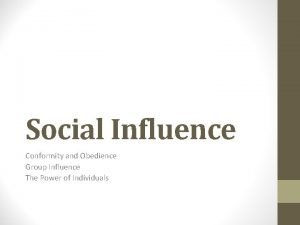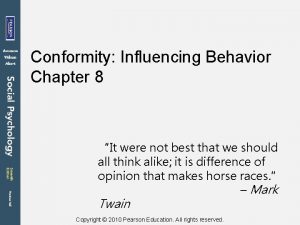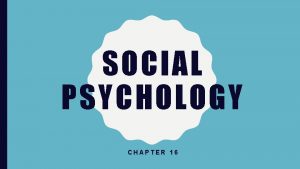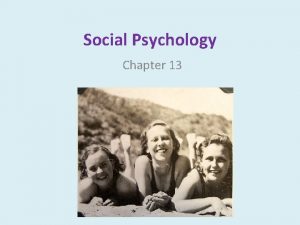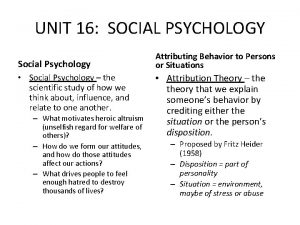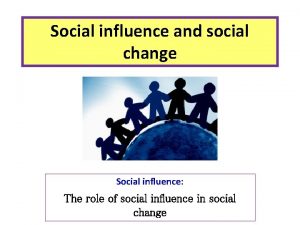AQA A Level Psychology Paper 1 Social Influence




































- Slides: 36

AQA A Level Psychology Paper 1: Social Influence

Specification Content; What the AQA say you should know… • Types of conformity: internalisation, identification and compliance. • Explanations for conformity: informational social influence and normative social influence. • Variables affecting conformity including group size, unanimity and task difficulty as investigated by Asch.

What is Conformity? Types of Conformity is a change in behaviour, attitudes or belief due to group pressure in order to fit in with the group. This pressure we feel can be either real or imagined. There are 3 different types of conformity. Compliance Maintaining own personal views on the inside whilst changing views and behaviours on the outside. Public change. Internalisation Acceptance of the groups point of view both publically & privately. Private & public change. Identification Accepting the views & behaviours of a group because ownership to the group is important. This is generally temporary & is not maintained once the individual leaves the group.

What is Conformity? Explanations of Conformity There are two reasons why people change their behaviour to fit in with others. This is called the Dual Dependency Model. Normative Social Influence People change their behaviour in order to be accepted by the group. i. e. the desire to be liked. This may be because belonging to a group is rewarding and groups have the power to punish or exclude people who do not fit in. The explanation of normative social influence is supported by Schultz (2008) Hotel guests exposed to the message that 75% of guests reused their towels each day, rather than requiring new ones, reduced their own towel use by 25%. This suggests that people shape their behaviour out of a desire to fit in. This process leads to compliance. Informational Social Influence People change their behaviour in order to be right. i. e. the desire to be correct. In some social situations people may be unsure of how to act or feel. In this case they look to others for appropriate ways to behave as the majority are likely to be right. This process leads to internalisation. The explanation of informational social influence is supported by Fein (2007). Judgements of candidate performance in US presidential debates could be influenced by knowledge of others’ reactions. Participants saw what was supposedly the reaction of their fellow participants on screen during the debate. This produced large shifts in the participants’ judgements of the candidates’ performance. This suggests that in unfamiliar situations people will be influenced by the judgements of others.

What is Conformity? Research investigating Conformity (Asch) Aim… The investigate the effects of majority influence on conformity. Procedure… • 123 male US undergraduates. • P’s were told they were taking part in a visual perception test. • Each group consisted of one true participant and five confederates. • The task was to state which line (A, B, or C) matched line X. The answer was always obvious but the confederates were told to deliberately give the wrong answer. • The real participant was always second to last to answer. • On 12 out of 18 trials confederates were instructed to give the same incorrect answer. (Critical trials) • Rate of conformity was measured by the number of wrong answers given by the participant. Findings… • • • On the critical trials the average conformity rate was 33% 25% never conformed on any of the critical trials. 50% conformed on 6 or more of the critical trials. Conclusion… Asch concluded that he had demonstrated the powerful effect of a majority influence on the conforming behaviour of individuals. When Asch interviewed his participants he found the majority who conformed still maintained their own private view but complied.

What is Conformity? Research investigating Conformity (Asch) Evidence that participants in Asch-type situations are highly emotional was obtained by Back et al. (1963) who found that participants in the Asch situation had greatly increased levels of autonomic arousal. Suggesting that they were in a conflict situation, finding it hard to decide whether to conform to the opinion of the confedreates Asch’s research may be a ‘child of it’s time’. The high levels of conformity may be a reflection of America in the 1950’s. America was very conservative, involved in an anti-communist witch-hunt (which became known as Mc. Carthyism) against anyone who was thought to hold sympathetic left-wing views. Conformity to American values was expected Asch also deceived the student volunteers claiming they were taking part in a 'vision' test; the real purpose was to see how the 'naive' participant would react to the behaviour of the confederates. Therefore participants did not give informed consent. The experiment used an artificial task to measure conformity - judging line lengths. How often are we faced with making a judgment like the one Asch used, where the answer is plain to see? This means that study has low ecological validity and the results cannot be generalized to other real-life situations of conformity Asch reported the results of his study as an astonishing rate of conformity with participants conforming to an obviously incorrect answer in 32% of critical trials. However that failed to acknowledge that in 68% of critical trials there was no conformity, and so perhaps the study was more a measure of factors that lead to resisting a majority rather than those that make conformity more likely. The study used a biased sample. All the participants were American male students who all belonged to the same age group. This means that the study lacks population validity and that the results cannot be generalized to females or older groups of people. The study may also lack temporal validity Perrin & Spencer replicated the Asch experiment using engineering, mathematics and chemistry students as subjects. They found that on only one out of 396 trials did an observer join the erroneous majority.

What is Conformity? Variables Affecting Conformity In further trials of his conformity experiments, Asch found that the following variables affected conformity… Group Size Difficulty of Task How do you think the size of the group will influence the level of conformity? How do you think the type of task will influence the level of conformity? What happens when people give different answers? Asch conducted a number of variations where he changed the number of confederates. When the majority was 2 confederates there was very little conformity. With three confederates it jumped to 30%. However, conformity levels stop increasing once the group has 4 people in it. In one variation Asch made the differences between the sizes of lines much smaller. This increased levels of conformity. Lucas investigated this further & found that self-efficacy effected this. In a study where participants were given a maths problem p’s with high selfefficacy remained non-conformist even when the task was difficult. When the real participant was given support by another real participant or a confederate conformity levels dropped to 5. 5%. When one participant (the ‘lone dissenter’) gave a different wrong answer to the other confederates conformity dropped to 9%. Unanimity

Specification Content; What the AQA say you should know… • Conformity to social roles as investigated by Zimbardo

Conformity to Social Roles What are Social Roles? Social roles are the ‘parts’ people play as members of various social groups. Everyday examples include parent, child, student, passenger etc. These are accompanied by expectations we & others have of what is appropriate behaviour in each role. We often change our behaviour to fit in with the role that we are playing in that situation. Identification Accepting the views & behaviours of a group because ownership to the group is important. This is generally temporary & is not maintained once the individual leaves the group.

Conformity to Social Roles Philip Zimbardo (1973) The Stanford Prison Experiment Aim… To investigate how ‘ordinary’ people placed in a prison would behave in their new social roles. Findings… • • Procedure… • • • 75 male student volunteers were psychologically & physically screened. 21 of the most stable were chosen & paid $15 a day for two weeks. A mock prison was set up in the basement of Stanford University. Participants were randomly assigned the role of prisoner or guard. (10 guards, 11 prisoners). Participants were arrested at their homes by local police, fingerprinted, stripped & deloused. Dehumanisation was increased by prisoners wearing numbered smocks, nylon stocking caps (to simulate shaved heads) & a chain around one ankle. Guards were given uniforms, reflective sunglasses, handcuffs, keys & truncheons. 9 prisoners were placed 3 to a cell & prisoners rights included 3 meals & 3 supervised toilet trips per day. Plus 2 visits a week. No physical violence was permitted. • • • Both guards & prisoners quickly settled into their roles. Within a few days guards grew increasingly abusive. They woke prisoners in the night & forced them to clean toilets with their bare hands & other degrading tasks. Participants seemed to forget it was role play & still acted in character when they were unaware they were being watched. Five prisoners had to be released early because of their extreme reactions (anxiety, rage etc. ). The study was terminated after 6 days. Conclusion… Individuals readily conform to the social roles demanded of a situation. The environment of the prison led to uncharacteristic behaviour from participants. (Situational explanation).

Conformity to Social Roles Philip Zimbardo (1973) The Stanford Prison Experiment Participants were not protected from psychological harm. Some of the participants experienced incidents of humiliation and distress. For example, one prisoner had to be released after 36 hours because of uncontrollable bursts of screaming, crying and anger. Zimbardo took on the role of prison superintendent of the prison & researcher. Critics have questioned whether he was able to oversee the research objectively. In his defence Zimbardo, did terminate the research after 6 days even though it was supposed to run for 14 days. According to Banuazizi & Movahedi the behaviour of the participants was due to demand characteristics. Most of the guards later claimed they were simply acting. Because the guards and prisoners were playing a role, their behaviour may not be influenced by the same factors which affect behaviour in real life. This lowers the internal validity of the findings The prisoners did not consent to being 'arrested' at home. The prisoners were not told partly because final approval from the police wasn’t given until minutes before the participants decided to participate, and partly because the researchers wanted the arrests to come as a surprise. However, this was a breach of the ethics of Zimbardo’s own contract that all of the participants had signed. There is considerable evidence that the participants did react to the situation as though it was real. For example, 90% of the prisoners’ private conversations, which were monitored by the researchers, were on the prison conditions, and only 10% of the time were their conversations about life outside of the prison. The study may also lack population validity as the sample comprised US male students. The study's findings cannot be applied to female prisons or those from other countries. For example, America is an individualist culture (were people are generally less conforming) and the results may be different in collectivist cultures (such as Asian countries). The harmful treatment of participant led to the formal recognition of ethical guidelines by the American Psychological Association. Studies must now undergo an extensive review by an institutional review board (US) or ethics committee (UK) before they are implemented. These boards review whether the potential benefits of the research are justifiable in the light of the possible risk of harm.

Specification Content; What the AQA say you should know… • Obedience to authority as investigated Milgram. • Situational variables affecting obedience including proximity, location and uniform, as investigated by Milgram.

Obedience to Authority: What is Obedience? A form of social influence in which an individual follows a direct order. The person issuing the order is usually a figure of authority, who has the power to punish when obedient behaviour doesn’t occur. Obedience is different to Conformity: Obedience Conformity Public acceptance Private change Explicit pressure Implicit pressure Conscious effects Unconscious effects

Obedience to Authority: Stanley Milgram (1963) Obedience to Authority Aim… Findings… To find out how far people would obey an unjust order given by an authority figure. • Procedure… • • • • He advertised in a local paper for male volunteers between the ages of 20 & 50 years to take part in a study about punishment & learning at Yale University. When participants arrived at Yale University they were introduced to Mr Wallace, who they thought was a real participant but was in fact a confederate. They were told that they were to be paired with Mr Wallace & that one of them would be the teacher & the other the learner & that this would be decided by picking names out of a hat (it was actually fixed so that Mr Wallace was always the learner). An experimenter who was wearing a grey lab coat took them into a room & strapped Mr Wallace to a chair & placed electrodes on his arms. The teacher was told that Mr Wallace had a mild heart condition. The experimenter & the teacher then went into an adjoining room & the teacher was shown the shock generator. This contained a row of switches ranging from 15 volts (slight shock) to 450 volts (XXX). The teacher did not know that the shock generator was fake. The only real shock that took place was when the teacher was given a 45 -volt shock to make the whole procedure convincing. The teacher was then told that he had to read out a number of word pairs, which the learner had to remember. If the learner gave an incorrect answer, or did not say anything, the teacher had to shock him. The shocks started at 15 v & increased by 15 v each time. The learner got the first few answers correct & then started to make mistakes. At 180 v the learner shouted that he could not stand the pain. At 300 v he banged on the wall & begged the teacher to stop. At 315 v there was silence When participants said they no longer wanted to continue the experimenter would respond with prods such as ‘The experiment requires you to continue’ & ‘Although the shocks are painful, there is no permanent tissue damage’. • • Before the experiment it was predicted by psychiatrists, psychologists & college students that only 1 in 1000 participants would complete the shock generator. 100% of participants went up to 300 v. 12. 5% stopped at 300 v. 65% delivered 450 v. When the experiment had ended (with the participant either refusing to go on or pressing 450 v three times) they were debriefed. They were introduced to Mr Wallace again, told the real reason for the experiment & assured that their behaviour was normal. Conclusion… People will obey an unjust order from a figure of authority even if it harms another person.

Obedience to Authority: Stanley Milgram (1963) Obedience to Authority The Milgram studies were conducted in laboratory type conditions, and we must ask if this tells us much about real-life situations. We obey in a variety of real-life situations that are far more subtle than instructions to give people electric shocks, and it would be interesting to see what factors operate in everyday obedience. The sort of situation Milgram investigated would be more suited to a military context. Orne & Holland (1968) accused Milgram’s study of lacking ‘experimental realism, '’ i. e. , ' participants might not have believed the experimental set-up they found themselves in and knew the learner wasn’t receiving electric shocks. The participants in Milgram's study were all male. Milgram’s study cannot be seen as representative of the American population as his sample was self-selected. This is because they became participants only by electing to respond to a newspaper advertisement. They may also have a typical "volunteer personality" – not all the newspaper readers responded so perhaps it takes this personality type to do so. Milgram’s findings have been replicated in a variety of cultures and most lead to the same conclusions as Milgram’s original study and in some cases see higher obedience rates. Smith & Bond (1998) point out that with the exception of Jordan (Shanab & Yahya, 1978), the majority of these studies have been conducted in industrialized Western cultures and we should be cautious before we conclude that a universal trait of social behavior has been identified. Deception – the participants actually believed they were shocking a real person and were unaware the learner was a confederate of Milgram's. However, Milgram argued that “illusion is used when necessary in order to set the stage for the revelation of certain difficultto-get-at-truths. ” Milgram also interviewed participants afterward to find out the effect of the deception. Apparently, 83. 7% said that they were “glad to be in the experiment, ” and 1. 3% said that they wished they had not been involved. Participants were exposed to extremely stressful situations that may have the potential to cause psychological harm. Many of the participants were visibly distressed. Signs of tension included trembling, sweating, stuttering, laughing nervously, biting lips and digging fingernails into palms of hands. Three participants had uncontrollable seizures, and many pleaded to be allowed to stop the experiment. The experimenter gave four verbal prods which mostly discouraged withdrawal from the experiment: 1. Please continue. 2. The experiment requires that you continue. 3. It is absolutely essential that you continue. 4. You have no other choice, you must go on. Milgram argued that they are justified as the study was about obedience so orders were necessary. Milgram pointed out that although the right to withdraw was made partially difficult, it was possible as 35% did withdraw.

Obedience to Authority: Hofling’s Nurses (1966) Aim… Findings… To examine obedience in a real life social setting - a hospital. (field experiment) • 21/22 of the nurses obeyed the telephone instruction and began to prepare the medication before they were stopped and the situation was explained to them. • When other nurses were asked to discuss what they would do in a similar situation (i. e. a control group), 21 out of 22 said they would not comply with the order. Procedure… • The study was set in a psychiatric hospital in the USA. 22 nurses on night duty were the participants. An unknown 'doctor', who was a confederate, telephoned the hospital and spoke to a nurse. • He instructed them to give medication to a patient. The medication was a drug with a maximum dosage of 10 Mg (which was shown on the label of the bottle). • The doctor instructed the nurse to give a dosage of 20 Mg to the patient and said that he would sign the relevant authorisation papers when he arrived in the hospital in 10 minutes time. • This was done with each of the 22 nurses. • If the nurse administers the drug, they will have broken three hospital rules: 1. They are not allowed to accept instructions over the phone. 2. The dose was double the maximum limit stated on the box. 3. The medicine itself as unauthorized, i. e. not on the ward stock list. • • The drug itself was a harmless sugar pill invented just for the experiment Conclusion… In their roles as nurses, it is the social norm to accept orders from the higher authority of the doctors without questioning their judgement. This shows that obedience is commonplace in everyday life.

Obedience to Authority: Situational Variables Affecting Obedience In further trials of his obedience experiments, Milgram found that the following variables affected obedience rates… Uniform Location Proximity How do you think the presence of uniform would affect the participants willingness to obey? How do you think the location of the experiment (Yale University) affected the obedience rate? How do you think the experimenter being in the same room affect the obedience levels? The experiment was moved to a set of run down offices rather than the impressive Yale University. Obedience dropped to 47. 5%. This suggests that status of location effects obedience. When the teacher had to force the learner's hand down onto a shock plate when they refuse to participate after 150 volts. Obedience fell to 30%. The participant is no longer buffered / protected from seeing the consequences of their actions. In the original baseline study – the experimenter wore a grey lab coat as a symbol of his authority (a kind of uniform). Milgram carried out a variation in which the experimenter was called away because of a phone call right at the start of the procedure. The role of the experimenter was then taken over by an ‘ordinary member of the public’ ( a confederate) in everyday clothes rather than a lab coat. The obedience level dropped to 20%.

Specification Content; What the AQA say you should know… • Explanations for obedience: agentic state and legitimacy of authority. • Dispositional explanations for obedience: the Authoritarian Personality.

Explanations of Obedience The Agentic State (AO 1) Agency Theory suggests humans have two mental states: 1. Autonomous: In the Autonomous State we perceive ourselves to be responsible for our own behaviour so we feel guilt for what we do 2. Agentic: In the Agentic State we perceive ourselves to be the agent of someone else’s will; the authority figure commanding us is responsible for what we do so we feel not guilt. We perceive some people to be “authority figures”. These people may carry symbols of authority (like a uniform) or possess status (like rank). An order from an authority figure triggers the agentic shift into the Agentic State. • Moral Strain When an authority figure issues an order that goes against our conscience, we experience moral strain. This is because we have two contradictory urges: to obey the authority figure (and society's expectations) and to obey our consciences (and keep our own self-image as "a good person"). Moral strain might appear as physical distress, like shaking or weeping. Milgram points out that his own participants used "defence mechanisms" (a term originally used by Freud) to lessen the moral strain: • Denial: some of the participants in Milgram's study minimised the pain they were causing to the Learner, convincing themselves that the shocks weren't dangerous (even though "DANGER" was written on the shock generator); Milgram argues that many people in Nazi Germany did this, refusing to believe what was going on in the death camps • Avoidance: many participants tried not to look at the Experimenter or even look up from the shock generator • Degree of Involvement: some participants only flicked the switches on the shock generator lightly, as if this would somehow lessen the pain Going into the Agentic State removes moral strain, because we regard the authority figure as now being responsible for our actions. This is the appeal of the Agentic State.

Explanations of Obedience The Agentic State (AO 3) In one variation of Milgram’s research the experimenter was not in the same room as the participant & gave instructions over telephone. Obedience declined from 62. 5% to 20. 5%. It is useful. If during training exercises people could be made aware of agentic states so that they can take responsibility for their own actions. In 2004, evidence from the Abu Graib prison in Iraq showed that prisoners of war where tortured and humiliated and US prison excused their actions for 'doing their job' Milgram reported that in his original study participants showed physical signs of distress but still obeyed Meeus & Raaijmakers (1986) found similar results in liberal Holland to what Milgram found in 1960 s America. However, this study used a less distressing punishment (insults, not electric shocks). Social Impact Theory suggests that everyone applies Social Force to everyone else to get what they want. Both theories regard people as passive, doing whatever social pressure makes them do. However, Social Impact Theory ignores the importance of moral strain. Agency Theory can help explain events like the Holocaust, the Rwandan genocide and the ethnic cleansings in the Balkans in the ‘ 90 s and in Syria today when these crimes are ordered by authority figures Ethical implications -remove personal responsibilities from those who commit atrocities under pressure. Offers an excuse for those 'just following orders' even though they aware what they have done is wrong. Levels of obedience from Milgram's study and the Holocaust show that some people may be more obedience then others, Zimmer suggested theory of an 'authoritarian personality' and used the psychometric test and found Nazi soldiers and US soldiers personalities to differ slightly.

Explanations of Obedience Legitimacy of Authority (AO 1) • From a young age people are socialised to obey authority figures. • We accept the power & status of authority figures; they are seen as being in charge. • We assume they know best, so we follow their orders based on this. • In order to obey authority, the obeying person has to accept that it is legitimate (i. e. rightful, legal) for the command to be made of them. • In Milgram’s 1963 experiment, the authority figure was an experimenter dressed in a light grey laboratory coat. The coat was a symbol of legitimate power and experience, and possibly led participants to believe that the experimenter was a legitimate authority figure. • Other examples of uniforms that convey the impression of legitimate authority in society are police officers, security guards, night club bouncers, fire fighters, nurses and doctors.

Explanations of Obedience Legitimacy of Authority (AO 3) Bickman (1974) used three male actors dressed in normal clothes, as a milkman, or as a security guard. The actors asked passers-by to do things like pick up a paper bag that had been thrown in the street, or to give them a coin for a parking meter. Passersby were most likely to obey the actor dressed as a security guard and least likely to obey the actor in normal clothes. Milgram reported that some participants in his study ignored the learners distress & appeared to suffer no distress themselves. Instead, they focused on following the procedure, e. g. by pressing the buttons properly. In this way, they can be seen to be doing their duty & thus recognising the legitimacy of authority Bickmans study was a field experiment with high ecological validity, however it used an opportunity sample that makes the results difficult to generalise beyond the people that just happened to be passing by. Milgram carried out a variation in which the experimenter was called away because of a phone call right at the start of the procedure. The role of the experimenter was then taken over by an ‘ordinary member of the public’ ( a confederate) in everyday clothes rather than a lab coat. The obedience level dropped to 20%.

Explanations of Obedience The Authoritarian Personality (AO 1) Authoritarian Personality Definition: A person who has extreme respect for authority & who is very obedient to those who have power over them. They may also be hostile to those of lower status. The F Scale Adorno created the F scale which consisted of 30 questions & measured 9 different personality dimensions. The F Scale contained statements such as ‘Obedience & respect for authority are the most important virtues children should learn’. Agreement with statements like this is indicative of an authoritarian personality. Individuals with this type of personality are rigid thinkers, who obey authority, see the world in black & white & enforce strict adherence to rules. Adorno found that people who scored highly on the F-Scale had been raised by authoritarian parents who used physical punishment. A child who grows up in an authoritarian family, with a strong emphasis on obedience also acquires this same attitude.

Explanations of Obedience The Authoritarian Personality (AO 3) Elms and Milgram (1966) tested 20 obedient participants, who administered the full 450 volts and 20 disobedient participants, who refused to continue. Each participant completed including Adorno’s F scale, to measure their level of authoritarian personality. They found that the obedient participants scored higher on the F scale, in comparison to disobedient participants. Middendorp and Meleon (1990) found that less-educated people are more likely to display authoritarian personality characteristics, than well-educated people. If these claims are correct then it is possible to conclude that it is not authoritarian personality characteristics that lead to obedience, but levels of education. Although the results of Elms and Milgram suggest a link between authoritarian personality and obedience, these results are correctional and it is therefore difficult to draw meaningful conclusions about the exact cause of the obedience. There are many other situational factors that contribute to obedience, including proximity, uniform and location. Therefore, although it is likely that authoritarian personality contributes to obedience, a range of situational variables can affect the level of this contribution. It is possible that the F scale suffers from response bias or social desirability, where participants provide answers that are socially acceptable. For example, participants may appear more authoritarian because they believe that their answers are the socially ‘correct’ and consequently they are incorrectly classified as authoritarian when they are not. Zillmer et al found Nazi war criminals scored highly on 3 of the personality dimensions of Adorno’s F-scale questionnaire but not all 9. This only gives limited support for the authoritarian personality suggesting it has limited validity. Altemeyer (1988) found that participants who were more willing to give themselves electric shocks were also identified as having an authoritarian personality type lending support for this explanation.

Specification Content; What the AQA say you should know… • Explanations of resistance to social influence, including: – Social Support – Locus of Control

Resistance to Social Influence Social Support Social support is the perception that an individual has assistance available from other people, and that they are part of a supportive network. How does social support affect conformity and obedience? Asch (1956) found that the presence of social support enables an individual to resist conformity pressure from the majority. In one of the variations in his study, the introduction of an ally who also have the right answer (and so appeared to resist the majority) caused conformity levels to drop from 33% to just 5. 5%. In one of Milgram’s variations, the participant was one of a team of three testing the learner. The other two were confederates who, one after the other, refused to continue shocking the learner and withdrew. In this condition only 10% of the true participants went all the way up to 450 V (compared with 66% in the original study). Rank and Jacobson (1977) replicated Hofling’s study making sure, the doctor on the phone used a real name, the doctor asked the nurses to prescribe a well-known drug (Valium), the nurses were given the opportunity to consult with other nurses. When given the opportunity for social support, only 2 out of 18 nurses obeyed the instruction.

Resistance to Social Influence: Gamson (1982) A real-life study of resisting obedience Aim… To investigate whether people would obey an unjust authority in a real-life setting. Procedure… • Participants answered an advert to take part in a study supposedly run by a public relations firm, MHRC. • Participants met in groups at a motel and were paid $10 for two hours’ work. • They were asked to consider the case of an employee, Mr. C, who was claimed to have behaved immorally, and give their opinions on video. • • It gradually became apparent that what the company wanted was some videotaped support for their views – the participants’ own views were ignored. At the end of each session each group was asked jointly to sign a form to allow the company to use the videotape. Findings… • Altogether 33 groups took part in this study and all but four of these groups refused to sign – i. e. they disobeyed authority. • In all groups there were some people who wished to obey but the presence of dissenters led to group disobedience. • Nine groups threatened legal action against MHRC! Conclusion… This study shows that when people are in a situation where they are subjected to an authority that is perceived to be unjust, they are highly unlikely to obey the unjust orders when placed in a group situation. This may be because individuals are generally more confident in their ability to resist the temptation to obey if they can find an ally who is willing to join them in opposing the authority figure.

Resistance to Social Influence: Gamson (1982) A real-life study of resisting obedience Gamson’s research had a high level of realism. This means that the behaviour of the participants was natural and could be better generalised to other situations giving it a high degree of ecological validity. The study used a volunteer sample, which means that the participants may have had volunteer personality and would be biased, thus lacking population validity. Gamson’s study was a controlled observation rather than an experiment. The rebellion could have been influenced by the potentially serious consequences of lying on film in court. The experiment held several ethical issues. Participants were deceived throughout a prolonged period of time- the news reports were fictional, as well as the sacking of a petrol station manager. Participants also experienced high stress levels since their actions were jeopardising the life of an individual. Smith and Mackie (2000) claimed that obedience can be low because of the importance given to a group. In the case of Gamson et als study people would not have disobeyed if they were on their own or if nobody else shared their opinion. However, since there was a strong group identity they were able to decide amongst themselves that the consent form was unreasonable. The presence of systematic processing was also put forward by Smith and Mackie (2000). Systematic processing is when people have time to consider their actions. This increases chances of disobedience because they have the ability to contemplate what they’ve been asked to do.

Resistance to Social Influence Locus of Control. The extent to which people believe they have power over events in their lives. A person with an internal locus of control believes that he or she can influence events and their outcomes, while someone with an external locus of control blames outside forces for everything. How does locus of control affect conformity and obedience?

Resistance to Social Influence Locus of Control How does Locus of Control affect conformity and obedience? Shute investigated the relationship between locus of control and conformity. He exposed undergraduate student participants to peers expressing negative or positive views to taking drugs. He also measured the participants’ locus of control. He found that participants with an internal locus of control were more able to resist the pressures to conform to their peers with pro-attitudes to drugs Holland investigated the relationship between locus of control and obedient behaviour. He did this using a number of variations of Milgram’s procedure. He found no relationship between scores on Rotter’s locus of control scale and levels of obedience. HOWEVER when this data was re-analysed by BLASS (1991) using more sophisticated statistical techniques, he found that those with an internal locus of control were more resistant to the pressures to obey. This was especially so if they felt that they were being manipulated by the experimenter. Williams and Warchal identified individuals who had high and low conformity scores on Asch type tasks in conformity research. They carried out LOC assessments on these individuals and found no difference between the two groups. Schurz conducted an Austrian study modelled on Milgram’s procedure. Participants were instructed to apply increasingly painful ultrasound simulation to a “learner” by pressing a switch. The participants were told that at the highest level of the 20 -step continuum the ultrasound could cause skin damage. 80% of participants pressed all twenty switches. Locus of control measures were not predictive of obedience or disobedience. However it was found that the 20% who resisted obedience tended to take more responsibility for their actions.

Specification Content; What the AQA say you should know… • Minority influence including reference to: – Consistency – Commitment – Flexibility • The role of social influence processes in social change

Minority Influence What is minority influence? Minority influence is a type of social influence whereby the views of a minority group challenges the views of a majority, leading to a reconsideration and eventual conversion of the majority viewpoint to that of the minority. In order to bring about this conversion process, minorities must be: • Consistent: A consistent viewpoint makes others reassess the situation and consider the issue more carefully! • Committed: Commitment suggests certainty, confidence and courage! • Flexible: Flexibility and negotiation is more effective than rigid argument, which can be perceived as dogmatic!

Minority Influence: Moscovici et al. (1969) The Blue Slides Study… Aim… To investigate whether a majority would conform to the views of a consistent minority. Findings… • • Procedure… • Four naïve participants were placed into a group with a minority of two confederates. • They were shown a series of blue slides that varied only in intensity and were asked to judge the colour of each slide. • In the “consistent” condition the confederates repeatedly called the blue slides “green”. • In the “inconsistent” condition the confederates called the slides “green” on 2/3 of the trials and “blue” on 1/3 of the trials. • Moscovici recorded any “green” responses by the naïve participants as a conforming response. • In a control condition comprising six naïve participants and no confederates, the participants called the slides “blue” throughout. • • • In the consistent condition, participants said “green” on over 8% of the trials. In the inconsistent condition the minority exerted very little influence – the results did not differ significantly from the control group. After the main study was over, participants were asked individually to sort 16 coloured discs into either “green” or “blue”. Three of these discs were unambiguously blue and three were unambiguously green. The remaining 10 were ambiguous in that they might be considered blue or green. Participants who were in the consistent condition judged more slides to be green than those who were in the inconsistent condition. Moscovici’s research demonstrates that, although levels of conformity are nowhere near as great as with majority influence, a consistent minority is far more influential than an inconsistent one. Conclusion…

Minority Influence: Moscovici et al. (1969) The Blue Slides Study… There is research support for the view that Minorities can influence a majority, but not all the time and only when they behave in certain ways (e. g. consistent behaviour style). Although it is seen as unethical to deceive participants, Moscovici’s experiment required deception in order to achieve valid results. If the participants were aware of the true aim, they might have displayed demand characteristics and acted differently. Most of the research on minority influence is based on experiments conducted in laboratories. This raises the question of ecological validity. Is it possible to generalize from the findings of laboratory research to other settin The participants in laboratory experiments are rarely 'real groups'. More often than not they are a collection of students who do not know each other and will probably never meet again. They are also involved in an artificial task. As such they are very different from minority groups in the wider society who seek to change majority opinion. Four people are not enough for a group and could not be considered as the majority – if there were more, would they have been able to change their minds? Moscovici (1969) used female students as participants (i. e. unrepresentative sample), so it would be wrong to generalize his result to all people – they only tell us about the behavior of female students. Also, females are said to be more conformist than males, therefore there might be a gender difference in the way that males and females respond to minority influence. Moscovici has also been criticised for deceiving his participants, as participants were told that they were taking part in a colour perception test. This also means that Moscovici did not gain fully informed consent. Although it is seen as unethical to deceive participants,

Social Change What is social change? Social change occurs when a society or section of society adopts a new belief or way of behaving which then becomes widely accepted as the norm. How does this Social Change occur? • Social change occurs as a result of minority influence. • Minority Influence is a form of social influence. • Where a persuasive minority exerts pressure to change the attitudes behaviours or beliefs of the majority. • However, minorities can only influence majorities if they behave in certain ways. • Moscivici (1985) says that minority groups must be consistent in their opposition, committed and have some degree of flexibility. • Hogg & Vaughn says that minority groups must be; seen to be acting from principle, have made sacrifices to maintain their position and be similar to the majority in terms of class, age and gender.

Social Change What is social change? Social change occurs when a society or section of society adopts a new belief or way of behaving which then becomes widely accepted as the norm. How does this Social Change occur? • Social change occurs as a result of minority influence. • Minority Influence is a form of social influence. • Where a persuasive minority exerts pressure to change the attitudes behaviours or beliefs of the majority. • However, minorities can only influence majorities if they behave in certain ways. • Moscivici (1985) says that minority groups must be consistent in their opposition, committed and have some degree of flexibility. • Hogg & Vaughn says that minority groups must be; seen to be acting from principle, have made sacrifices to maintain their position and be similar to the majority in terms of class, age and gender.
 Aqa psychology a level paper 1
Aqa psychology a level paper 1 Psychology a level relationships
Psychology a level relationships Social thinking and social influence
Social thinking and social influence Social thinking and social influence
Social thinking and social influence Aqa a level chemistry paper 1 2020
Aqa a level chemistry paper 1 2020 Psychology aqa a level spec
Psychology aqa a level spec Social thinking social influence social relations
Social thinking social influence social relations Informational social influence
Informational social influence Normative social influence
Normative social influence Informational social influence psychology definition
Informational social influence psychology definition Dispositional attribution ap psychology
Dispositional attribution ap psychology Aqa english language paper 1
Aqa english language paper 1 Human geography revision
Human geography revision Aqa eng lang paper 2
Aqa eng lang paper 2 English language paper 2 rail disasters mark scheme
English language paper 2 rail disasters mark scheme Aqa economics paper 3 specimen 2015
Aqa economics paper 3 specimen 2015 An inspector calls past papers
An inspector calls past papers English literature paper 1 macbeth and inspector calls
English literature paper 1 macbeth and inspector calls Rs gcse past papers
Rs gcse past papers Aqa history 8 mark question structure
Aqa history 8 mark question structure Glastonbury festival and greenwich fair answers
Glastonbury festival and greenwich fair answers Aqa english literature paper 1 2019 a christmas carol
Aqa english literature paper 1 2019 a christmas carol Social thinking theory
Social thinking theory Behavioural approach to explaining phobias
Behavioural approach to explaining phobias Countercurrent exchange in fish
Countercurrent exchange in fish Antonin artaud bbc bitesize
Antonin artaud bbc bitesize Aqa physics required practicals
Aqa physics required practicals Aqa alevel data sheet
Aqa alevel data sheet Aqa a level english literature b poetry anthology
Aqa a level english literature b poetry anthology Aqa a level art and design
Aqa a level art and design Aqa gcse art and design
Aqa gcse art and design Art and design a level aqa
Art and design a level aqa Aqa a level biology transition guide answers
Aqa a level biology transition guide answers Mid tudor crisis essay aqa
Mid tudor crisis essay aqa Group polarization example
Group polarization example Fundamental attribution error ap psychology
Fundamental attribution error ap psychology Social psychology is the scientific study of:
Social psychology is the scientific study of:








